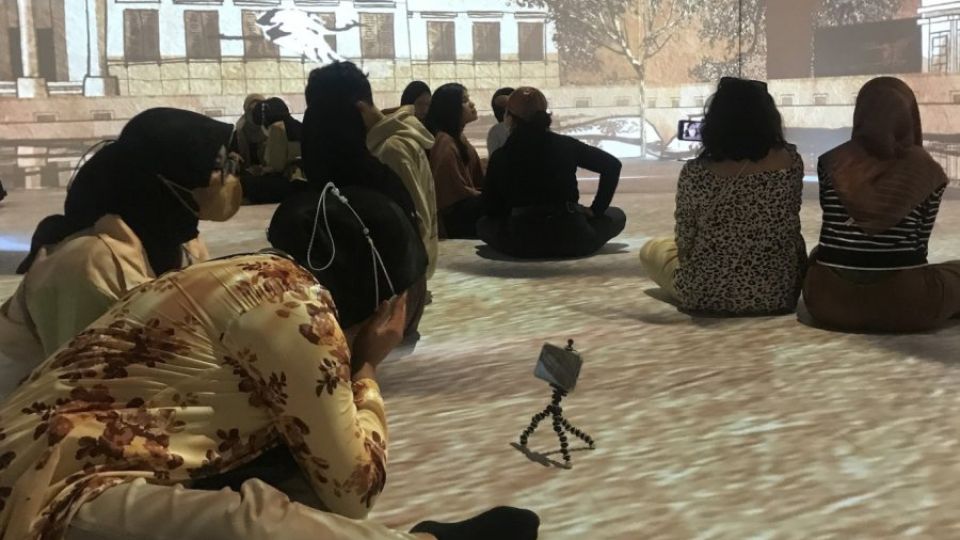March 6, 2023
JAKARTA – ImersifA, an interactive exhibit at the National Museum, is designed to immerse visitors in various periods of Indonesian history, from the prehistoric era to the last years of Dutch colonial rule in the mid-20th century.
Visitors sat in the middle of the hall, their senses filled with a kaleidoscope of images and sounds from the video footage and narration surrounding them. Sabre-toothed tigers and mammoths roamed across a savanna evoking those in Africa, before the visual shifted to prehistoric men hunting elephants and other large herbivores.
At a glance, the all-encompassing experience might seem to belong in a natural history museum in New York or London. But in fact, the immersive experience was taking place in an exhibition hall at the National Museum, dubbed Museum Gajah (elephant museum) for the iconic elephant statue in its front courtyard.
Immersive history
The film and audio narration are part of ImersifA, a permanent exhibit at Building A of the National Museum in Central Jakarta. The 30-minute video mapping exhibit covers various eras in Indonesian history spanning thousands of years, from prehistory to the 1945 independence movement.
“It is an interactive tour that is designed to attract visitors, especially young people, which [explores] history and the past using contemporary means. The spectacle in the 12-by-21-meter room is 360 degrees and even extends to the floor to simulate being part of history,” says an article on the ImersifA exhibit published on the museum website.
“ImersifA shows the development of Indonesia’s natural environment, society, history and culture across various eras through the eyes [of the country’s] history makers. Like them, visitors can explore the treasures and diversity of Indonesia’s cultures, traditions and historic monuments, and then feel their emotions as they see these aspects in a new light,” it continues.
Aside from the historical eras, ImersifA also touches on Indonesia’s creation myths and folk beliefs. These include the battle between the Hindu elephant god Ganesha and the giant Nila Rudraka, during which Ganesha defeats the giant despite losing one of his tusks. The myth is commonly believed to be the origin of potong gigi, the tooth filing tradition still practiced in Bali.
The exhibit also explores Indonesia’s maritime history and traditions, including trade between the Sriwijaya empire of the 7th to 13th centuries AD with other contemporary powers, such as China’s Tang Dynasty in or the Umayyad Caliphate, the first Muslim dynasty that ruled much of what is the Middle East today.
The equally iconic Majapahit empire is highlighted, not least the Javanese maritime power’s hegemony over much of Southeast Asia as well as the African island of Madagascar. The interactive tour also highlights the Bugis seafaring people of the islands of Sulawesi and Bawean.
The exhibit also traverses the history of transportation across the Indonesian archipelago, such as Sulawesi’s pinisi ships and the role of railroads in trade and the movement of people, particularly during the heyday of Dutch rule in the 19th century.
Presented in 3D, the immersive exhibit allows visitors to experience history, including that of Jakarta and other cities through their architecture. In all, ImersifA is an experiential complement to the statues, bas-reliefs, relics and other national treasures in the National Museum’s collection.
Food for thought
The National Museum hopes that ImersifA will “enable visitors to learn about [Indonesia’s] culture in a fun way, so as to raise awareness and understanding, particularly among youth, about the relevance and power of Indonesian culture. We also hope the exhibit will raise awareness about their national identity as Indonesians”.
This point was not lost on visitors to the exhibit.
“I was particularly taken by the natural history aspects of the exhibit, among them the volcanoes that dot the country. I was also impressed by the recreations of the temples and their scale in the exhibit,” said Putri, a visitor.
Sari, another exhibition visitor, agreed. “The scale of Indonesian history was portrayed impressively overall. But best of all, the shifting images and sounds make for great selfies, photos and videos,” she said with a laugh.
Whether visiting on a day off with friends or for a history lesson, ImersifA is a one-of-a-kind take on the country’s history.
ImersifA
National Museum
Jl. Medan Merdeka Barat No.12
Gambir, Central Jakarta 10110
Open daily 8 a.m.-4 p.m., except national holidays
Tickets: Rp 35,000 (excludes museum entrance fee)
www.museumnasional.or.id
Exhibit launch on YouTube: Museum Nasional Indonesia


